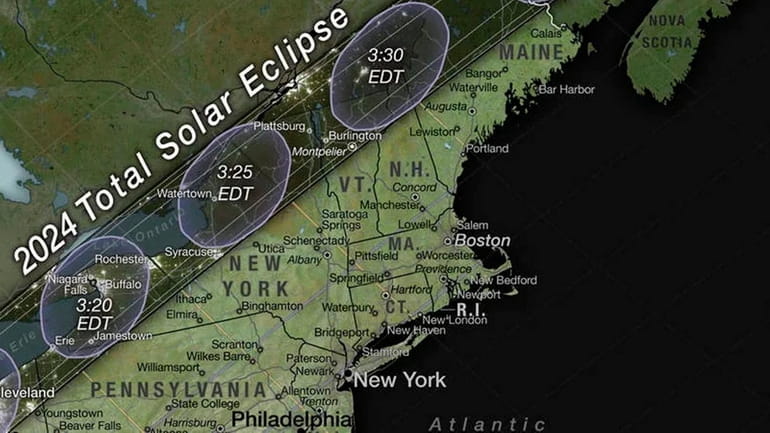Long Island preparing for New York's solar eclipse

The path of the April 8 solar eclipse. Credit: NASA/Michala Garrison; Ernie Wright
New Yorkers, get ready.
The first total solar eclipse to encompass the state in nearly a century will pass over 29 counties on April 8. Although Long Island isn’t in the path of totality, when the moon covers the bright face of the sun, the Island can still expect to see 88% of the celestial event.
The total eclipse will encompass the western and northern parts of New York that Monday afternoon, according to state officials, with the moon passing between the earth and sun. The eclipse should occur between 3:15 and 3:30 p.m.
Sunlight will be blocked for about 1½ to 3½ minutes. The entire event, from the time the sun is first obstructed to the last moments the moon’s shadow is cast, will last up to 2½ hours, the state said.
The path where the eclipse will completely block out the sun, roughly 100 miles wide, will begin in southwestern New York just after 3:15 and depart northern New York just before 3:30 p.m., affecting cities and towns that include Buffalo, Lake Placid, Plattsburgh, Rochester and Syracuse, according to the state.
The rest of New York is still expected to see anywhere from 88% to more than 99% coverage, with Long Island seeing the least solar coverage. New York City will see 89% coverage.
The partial eclipse on Long Island might show as a “slight darkening of the sky,” said Dave Bush, planetarium director at the Suffolk County Vanderbilt Museum and Planetarium.
“The moon will cover most of the sun,” Bush said, “but just a little thin sliver of the sun will still be there, and even with that small, thin sliver of the sun still visible, it looks like an ordinary day.”
Stony Brook University physics and astronomy professor Frederick Walter said even if the sun was 90% blocked, it will still burn an observer's retina during a total eclipse. He advised Long Islanders who plan to view the event to purchase certified eye protection, not sunglasses, and to avoid looking directly at the sun.
“It's the last total solar eclipse in the continental United States until the year 2044,” he said. “If you've never seen a total eclipse of the sun, it's worth seeing.”
Bush said if the skies are clear, the Vanderbilt Planetarium will have a solar telescope available for visitors.
“My best recommendation for any Long Islander, if they're capable of doing it, take the time to take a road trip. It is a very rare opportunity,” he said.
The next total solar eclipse to pass over New York will be in 2079.
State officials have said they expected hundreds of thousands of solar tourists to swarm the state for the once-in-a-generation spectacle.
Over the last year, nearly two dozen state agencies and authorities have worked with local governments to accommodate the influx of tourists and ensure public safety during the event.
One focus of the interagency task force is encouraging eclipse viewers to stay after it ends, partially to avoid massive backups like the one seen after a cross-country eclipse in 2017 that ran from Oregon to South Carolina.
Viewers should avoid stopping on busy roads to view it, officials advised.
The marketing campaign “I LOVE NY” has launched a website with more details about how to view the eclipse.
Bush also recommended viewing information about the eclipse's path at Eclipse2024.org.
New Yorkers, get ready.
The first total solar eclipse to encompass the state in nearly a century will pass over 29 counties on April 8. Although Long Island isn’t in the path of totality, when the moon covers the bright face of the sun, the Island can still expect to see 88% of the celestial event.
The total eclipse will encompass the western and northern parts of New York that Monday afternoon, according to state officials, with the moon passing between the earth and sun. The eclipse should occur between 3:15 and 3:30 p.m.
Sunlight will be blocked for about 1½ to 3½ minutes. The entire event, from the time the sun is first obstructed to the last moments the moon’s shadow is cast, will last up to 2½ hours, the state said.
The path where the eclipse will completely block out the sun, roughly 100 miles wide, will begin in southwestern New York just after 3:15 and depart northern New York just before 3:30 p.m., affecting cities and towns that include Buffalo, Lake Placid, Plattsburgh, Rochester and Syracuse, according to the state.
The rest of New York is still expected to see anywhere from 88% to more than 99% coverage, with Long Island seeing the least solar coverage. New York City will see 89% coverage.
The partial eclipse on Long Island might show as a “slight darkening of the sky,” said Dave Bush, planetarium director at the Suffolk County Vanderbilt Museum and Planetarium.
“The moon will cover most of the sun,” Bush said, “but just a little thin sliver of the sun will still be there, and even with that small, thin sliver of the sun still visible, it looks like an ordinary day.”
Stony Brook University physics and astronomy professor Frederick Walter said even if the sun was 90% blocked, it will still burn an observer's retina during a total eclipse. He advised Long Islanders who plan to view the event to purchase certified eye protection, not sunglasses, and to avoid looking directly at the sun.
“It's the last total solar eclipse in the continental United States until the year 2044,” he said. “If you've never seen a total eclipse of the sun, it's worth seeing.”
Bush said if the skies are clear, the Vanderbilt Planetarium will have a solar telescope available for visitors.
“My best recommendation for any Long Islander, if they're capable of doing it, take the time to take a road trip. It is a very rare opportunity,” he said.
The next total solar eclipse to pass over New York will be in 2079.
State officials have said they expected hundreds of thousands of solar tourists to swarm the state for the once-in-a-generation spectacle.
Over the last year, nearly two dozen state agencies and authorities have worked with local governments to accommodate the influx of tourists and ensure public safety during the event.
One focus of the interagency task force is encouraging eclipse viewers to stay after it ends, partially to avoid massive backups like the one seen after a cross-country eclipse in 2017 that ran from Oregon to South Carolina.
Viewers should avoid stopping on busy roads to view it, officials advised.
The marketing campaign “I LOVE NY” has launched a website with more details about how to view the eclipse.
Bush also recommended viewing information about the eclipse's path at Eclipse2024.org.
Latest on Stony Brook graduation plans ... Breaking down Rangers win ... Knicks game preview ... Dreams come true at new boutique
Latest on Stony Brook graduation plans ... Breaking down Rangers win ... Knicks game preview ... Dreams come true at new boutique

